Top companies trust Airbyte to centralize their Data









This includes selecting the data you want to extract - streams and columns -, the sync frequency, where in the destination you want that data to be loaded.




This includes selecting the data you want to extract - streams and columns -, the sync frequency, where in the destination you want that data to be loaded.

Set up a source connector to extract data from in Airbyte
Choose from one of 300+ sources where you want to import data from. This can be any API tool, cloud data warehouse, database, data lake, files, among other source types. You can even build your own source connector in minutes with our no-code connector builder.


Configure the connection in Airbyte
Ship more quickly with the only solution that fits ALL your needs.
As your tools and edge cases grow, you deserve an extensible and open ELT solution that eliminates the time you spend on building and maintaining data pipelines
Leverage the largest catalog of connectors
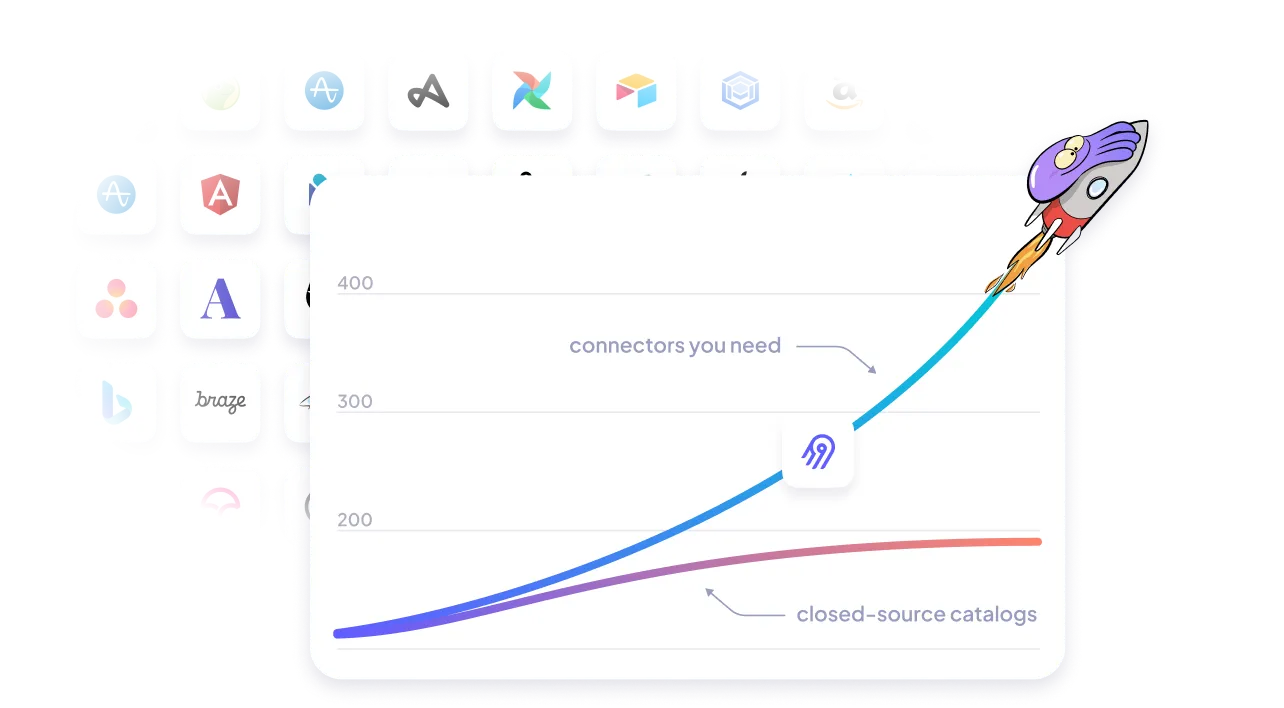
Cover your custom needs with our extensibility
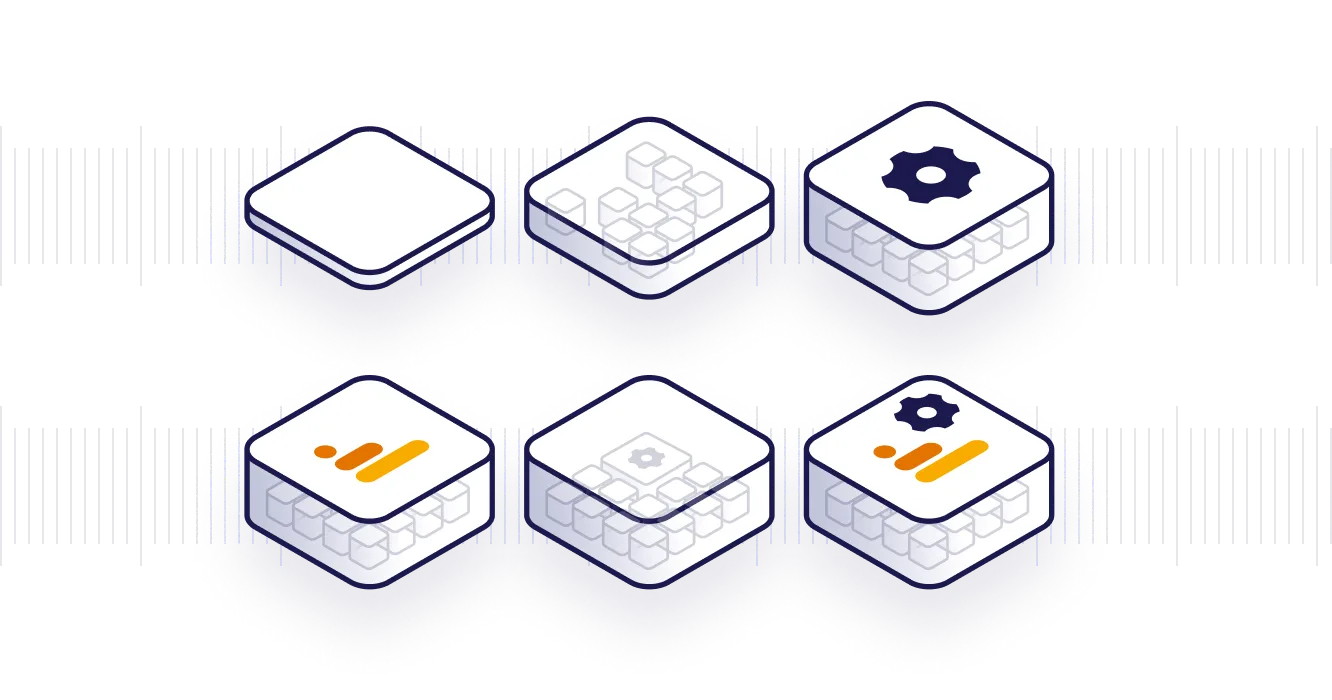
Free your time from maintaining connectors, with automation
- Automated schema change handling, data normalization and more
- Automated data transformation orchestration with our dbt integration
- Automated workflow with our Airflow, Dagster and Prefect integration
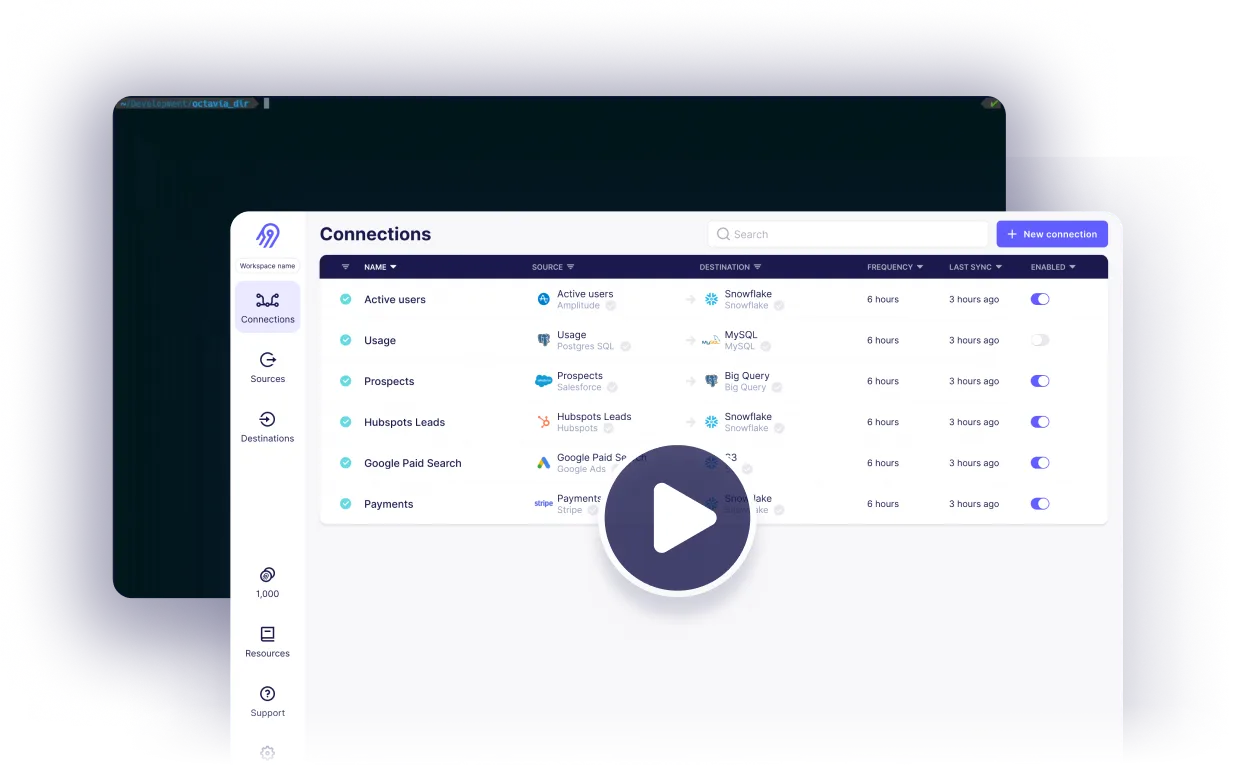
Reliability at every level



Ship more quickly with the only solution that fits ALL your needs.
As your tools and edge cases grow, you deserve an extensible and open ELT solution that eliminates the time you spend on building and maintaining data pipelines
Leverage the largest catalog of connectors

Cover your custom needs with our extensibility

Free your time from maintaining connectors, with automation
- Automated schema change handling, data normalization and more
- Automated data transformation orchestration with our dbt integration
- Automated workflow with our Airflow, Dagster and Prefect integration

Reliability at every level



Ship more quickly with the only solution that fits ALL your needs.
As your tools and edge cases grow, you deserve an extensible and open ELT solution that eliminates the time you spend on building and maintaining data pipelines
Leverage the largest catalog of connectors

Cover your custom needs with our extensibility

Free your time from maintaining connectors, with automation
- Automated schema change handling, data normalization and more
- Automated data transformation orchestration with our dbt integration
- Automated workflow with our Airflow, Dagster and Prefect integration

Reliability at every level



Move large volumes, fast.
Change Data Capture.
Security from source to destination.

We support the CDC methods your company needs
Log-based CDC



Timestamp-based CDC


Airbyte Open Source


Airbyte Cloud

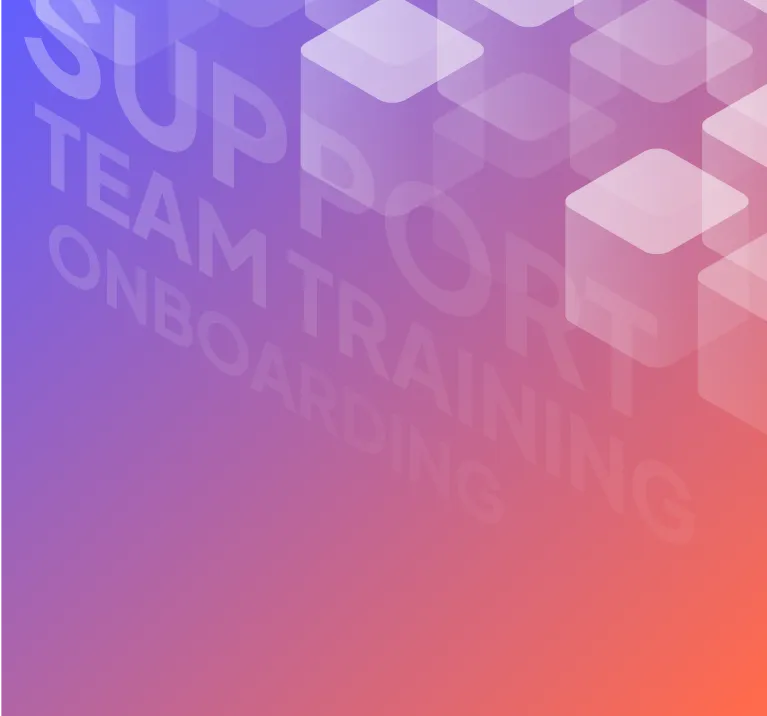
Airbyte Enterprise

Why choose Airbyte as the backbone of your data infrastructure?
Keep your data engineering costs in check
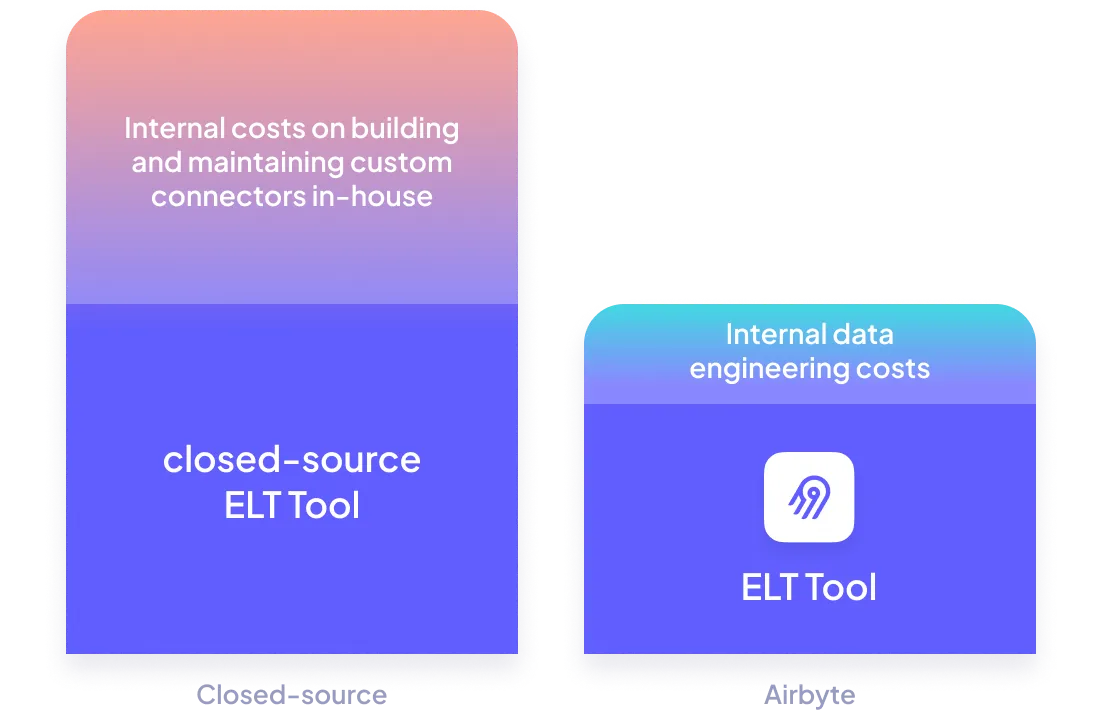
Get Airbyte hosted where you need it to be
- Airbyte Cloud: Have it hosted by us, with all the security you need (SOC2, ISO, GDPR, HIPAA Conduit).
- Airbyte Enterprise: Have it hosted within your own infrastructure, so your data and secrets never leave it.

White-glove enterprise-level support
Including for your Airbyte Open Source instance with our premium support.
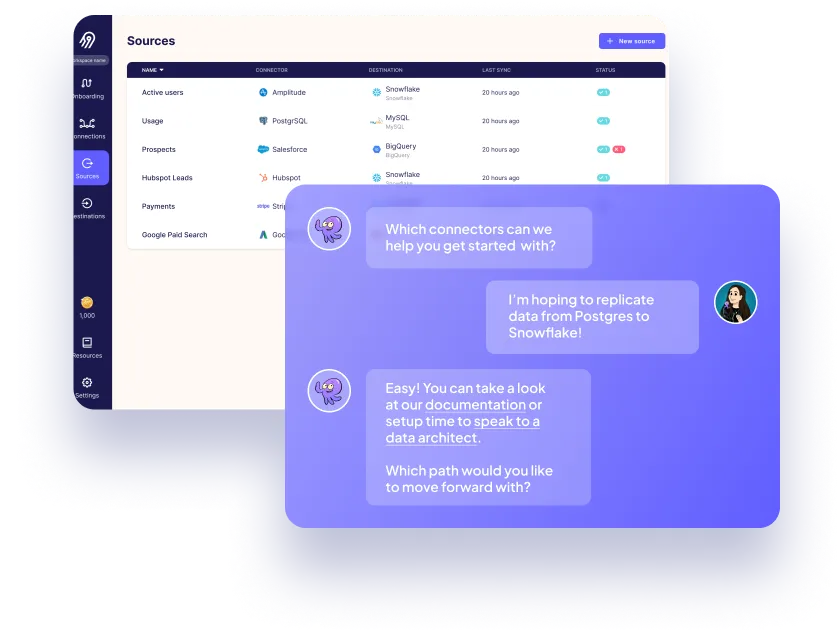
Airbyte supports a growing list of destinations, including cloud data warehouses, lakes, and databases.
Airbyte supports a growing list of destinations, including cloud data warehouses, lakes, and databases.
Airbyte supports a growing list of sources, including API tools, cloud data warehouses, lakes, databases, and files, or even custom sources you can build.



Fnatic, based out of London, is the world's leading esports organization, with a winning legacy of 16 years and counting in over 28 different titles, generating over 13m USD in prize money. Fnatic has an engaged follower base of 14m across their social media platforms and hundreds of millions of people watch their teams compete in League of Legends, CS:GO, Dota 2, Rainbow Six Siege, and many more titles every year.
Ready to get started?
FAQs
What is ETL?
ETL, an acronym for Extract, Transform, Load, is a vital data integration process. It involves extracting data from diverse sources, transforming it into a usable format, and loading it into a database, data warehouse or data lake. This process enables meaningful data analysis, enhancing business intelligence.
Zuora provides cloud-based software on a subscription basis that enables companies in various industries to launch, manage, and transform into a subscription business. The firm offers Zuora Central platform that acts as an intelligent subscription management hub that automates the subscription order-to-cash process, including quoting, billing, collections, analytics, and revenue recognition. Its products include Zuora Billing, Zuora RevPro, Zuora CPQ, Zuora Insights, and Zuora Collect. Zuora caters to various industries comprising software, hardware, media, transportation, construction, healthcare, education, retail, Internet of Things, and others worldwide.
Zuora's API provides access to a wide range of data related to subscription management, billing, and revenue recognition. The following are the categories of data that can be accessed through Zuora's API:
1. Accounts: Information related to customer accounts, such as account balance, payment history, and billing information.
2. Subscriptions: Details about the subscriptions, including subscription status, renewal dates, and pricing information.
3. Products and Catalogs: Information about the products and services offered by the company, including pricing, discounts, and promotions.
4. Payments: Details about the payments made by customers, including payment method, amount, and date.
5. Invoices: Information about the invoices generated for customers, including invoice amount, due date, and payment status.
6. Revenue Recognition: Data related to revenue recognition, including revenue schedules, recognition rules, and revenue reports.
7. Usage: Information about the usage of the products and services offered by the company, including usage data, usage charges, and usage reports.
8. Integrations: Data related to integrations with other systems, including API calls, webhooks, and data synchronization.
Overall, Zuora's API provides a comprehensive set of data that can be used to manage subscriptions, billing, and revenue recognition for businesses.
What is ELT?
ELT, standing for Extract, Load, Transform, is a modern take on the traditional ETL data integration process. In ELT, data is first extracted from various sources, loaded directly into a data warehouse, and then transformed. This approach enhances data processing speed, analytical flexibility and autonomy.
Difference between ETL and ELT?
ETL and ELT are critical data integration strategies with key differences. ETL (Extract, Transform, Load) transforms data before loading, ideal for structured data. In contrast, ELT (Extract, Load, Transform) loads data before transformation, perfect for processing large, diverse data sets in modern data warehouses. ELT is becoming the new standard as it offers a lot more flexibility and autonomy to data analysts.
What is ETL?
ETL, an acronym for Extract, Transform, Load, is a vital data integration process. It involves extracting data from diverse sources, transforming it into a usable format, and loading it into a database, data warehouse or data lake. This process enables meaningful data analysis, enhancing business intelligence.
Zuora provides cloud-based software on a subscription basis that enables companies in various industries to launch, manage, and transform into a subscription business. The firm offers Zuora Central platform that acts as an intelligent subscription management hub that automates the subscription order-to-cash process, including quoting, billing, collections, analytics, and revenue recognition. Its products include Zuora Billing, Zuora RevPro, Zuora CPQ, Zuora Insights, and Zuora Collect. Zuora caters to various industries comprising software, hardware, media, transportation, construction, healthcare, education, retail, Internet of Things, and others worldwide.
Zuora's API provides access to a wide range of data related to subscription management, billing, and revenue recognition. The following are the categories of data that can be accessed through Zuora's API:
1. Accounts: Information related to customer accounts, such as account balance, payment history, and billing information.
2. Subscriptions: Details about the subscriptions, including subscription status, renewal dates, and pricing information.
3. Products and Catalogs: Information about the products and services offered by the company, including pricing, discounts, and promotions.
4. Payments: Details about the payments made by customers, including payment method, amount, and date.
5. Invoices: Information about the invoices generated for customers, including invoice amount, due date, and payment status.
6. Revenue Recognition: Data related to revenue recognition, including revenue schedules, recognition rules, and revenue reports.
7. Usage: Information about the usage of the products and services offered by the company, including usage data, usage charges, and usage reports.
8. Integrations: Data related to integrations with other systems, including API calls, webhooks, and data synchronization.
Overall, Zuora's API provides a comprehensive set of data that can be used to manage subscriptions, billing, and revenue recognition for businesses.
What is ELT?
ELT, standing for Extract, Load, Transform, is a modern take on the traditional ETL data integration process. In ELT, data is first extracted from various sources, loaded directly into a data warehouse, and then transformed. This approach enhances data processing speed, analytical flexibility and autonomy.
Difference between ETL and ELT?
ETL and ELT are critical data integration strategies with key differences. ETL (Extract, Transform, Load) transforms data before loading, ideal for structured data. In contrast, ELT (Extract, Load, Transform) loads data before transformation, perfect for processing large, diverse data sets in modern data warehouses. ELT is becoming the new standard as it offers a lot more flexibility and autonomy to data analysts.
What is ETL?
ETL, an acronym for Extract, Transform, Load, is a vital data integration process. It involves extracting data from diverse sources, transforming it into a usable format, and loading it into a database, data warehouse or data lake. This process enables meaningful data analysis, enhancing business intelligence.
Zuora provides cloud-based software on a subscription basis that enables companies in various industries to launch, manage, and transform into a subscription business. The firm offers Zuora Central platform that acts as an intelligent subscription management hub that automates the subscription order-to-cash process, including quoting, billing, collections, analytics, and revenue recognition. Its products include Zuora Billing, Zuora RevPro, Zuora CPQ, Zuora Insights, and Zuora Collect. Zuora caters to various industries comprising software, hardware, media, transportation, construction, healthcare, education, retail, Internet of Things, and others worldwide.
Zuora's API provides access to a wide range of data related to subscription management, billing, and revenue recognition. The following are the categories of data that can be accessed through Zuora's API:
1. Accounts: Information related to customer accounts, such as account balance, payment history, and billing information.
2. Subscriptions: Details about the subscriptions, including subscription status, renewal dates, and pricing information.
3. Products and Catalogs: Information about the products and services offered by the company, including pricing, discounts, and promotions.
4. Payments: Details about the payments made by customers, including payment method, amount, and date.
5. Invoices: Information about the invoices generated for customers, including invoice amount, due date, and payment status.
6. Revenue Recognition: Data related to revenue recognition, including revenue schedules, recognition rules, and revenue reports.
7. Usage: Information about the usage of the products and services offered by the company, including usage data, usage charges, and usage reports.
8. Integrations: Data related to integrations with other systems, including API calls, webhooks, and data synchronization.
Overall, Zuora's API provides a comprehensive set of data that can be used to manage subscriptions, billing, and revenue recognition for businesses.
1. Open the Airbyte platform and navigate to the "Sources" tab on the left-hand side of the screen.
2. Click on the "Add Source" button and select "Zuora" from the list of available connectors.
3. Enter a name for the Zuora source connector and click on the "Next" button.
4. Enter the following credentials for your Zuora account:
- API Username
- API Password
- API Endpoint
5. Click on the "Test" button to ensure that the credentials are correct and the connection is successful.
6. Once the test is successful, click on the "Save" button to save the Zuora source connector.
7. You can now configure the Zuora source connector by selecting the tables and fields that you want to sync with Airbyte.
8. After configuring the Zuora source connector, click on the "Create Connection" button to create a new connection.
9. Select the Zuora source connector that you just created and enter the destination connector that you want to sync the data to.
10. Follow the prompts to complete the connection setup and start syncing data between Zuora and your destination.
What is ELT?
ELT, standing for Extract, Load, Transform, is a modern take on the traditional ETL data integration process. In ELT, data is first extracted from various sources, loaded directly into a data warehouse, and then transformed. This approach enhances data processing speed, analytical flexibility and autonomy.
Difference between ETL and ELT?
ETL and ELT are critical data integration strategies with key differences. ETL (Extract, Transform, Load) transforms data before loading, ideal for structured data. In contrast, ELT (Extract, Load, Transform) loads data before transformation, perfect for processing large, diverse data sets in modern data warehouses. ELT is becoming the new standard as it offers a lot more flexibility and autonomy to data analysts.




































